 Traditional Landscape by Dc Metro Landscape Architects & Landscape Designers Katia Goffin Gardens (via Houzz)
Traditional Landscape by Dc Metro Landscape Architects & Landscape Designers Katia Goffin Gardens (via Houzz)Above you see what I think of as Classic Hydrangea. A community, massed in uniform volume, vegetable origin a distant memory. Transmuted from plant to decor. All well and good. But there’s another mode of hydrangea to consider – the Shy Woodland Creature. And such I’ve come to love.
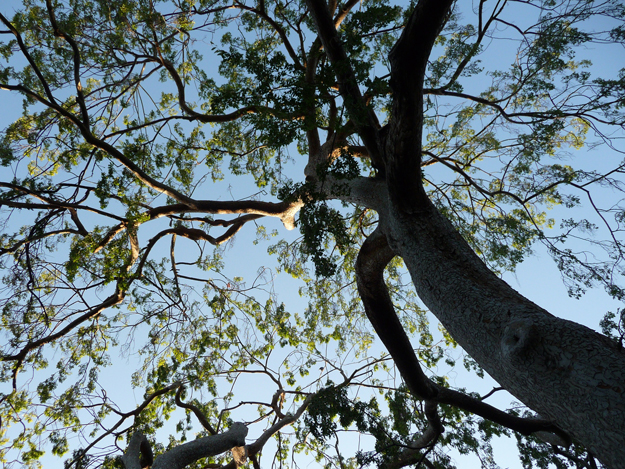
To set context, my backyard is a woodland. Well, in the same way as my front yard is a cottage garden, i.e. a Northern California remix of the archetype. One aging but stalwart 60-year old Chinese Evergreen Elm shades a very small gathering of woodland-ish plants. I use the “Ish” suffix advisedly, as you will see. This is an imaginary forest made up of plants from everywhere.
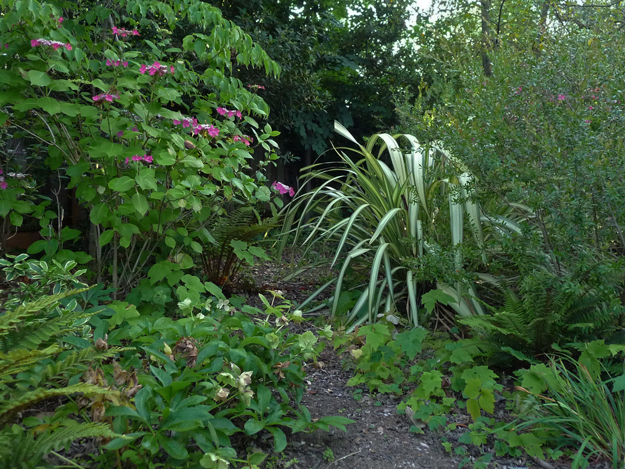
Here’s the forest-ish floor. Starting from the lower left-hand corner: ferns, hellebore, a path that needs new bark cover, native iris, Japanese anemones, a woody shrub whose name I do not know so sue me, phormium (AKA New Zealand Flax – I told you it was a global forest – of the yellow-leaved variety,) lacecap hydrangea (hydrangea macrophylla normalis – why normalis we wonder?) and the branches of a rather young dogwood.
The hydrangea at left mingles with the dogwood foliage. Look to the right, and you’ll see there’s another Hyding behind Nameless Woody Shrub. Get it? Nothing like gardening to bring out the dumb humor.
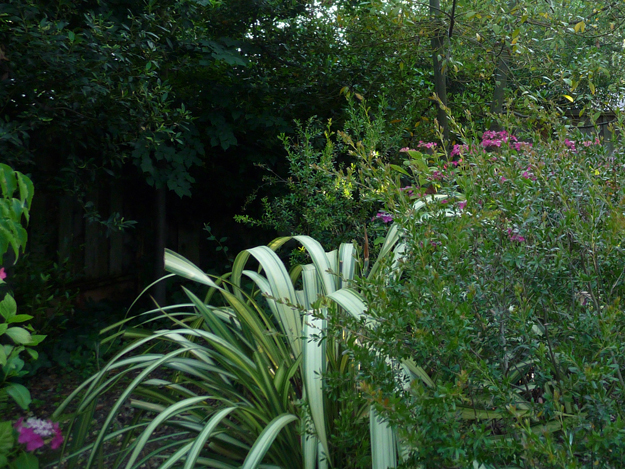
Look closer. When the wind blows, both shrub and phormium wave, causing pink to flicker through the mostly green of my yard. I should note that my living area (kitchen, dining, sofa-intensive-comfort-zone) is lined with windows and this is the view. Excellent for general calming of the spirit.
I’ve read that nature’s patterns, like leaves in the sunlight and the waving of branches, do in fact settle our metabolisms. How about that.
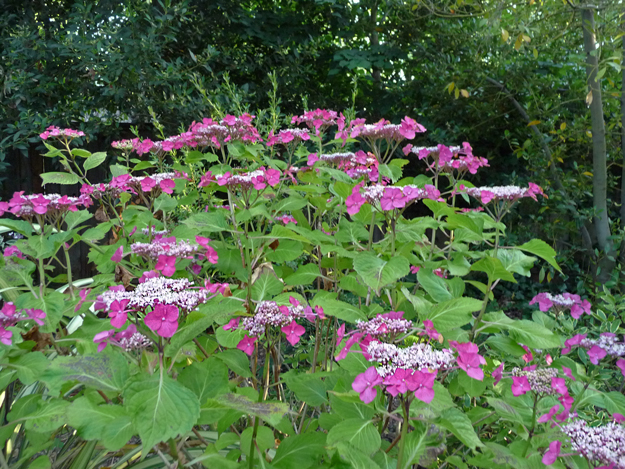
In this garden, you have to wander to find the grace of complex flower heads. Set foot on a path.
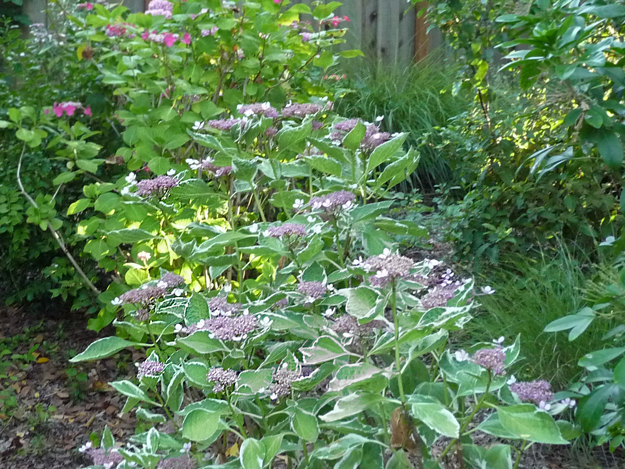
I have two lacecap varieties by the way, one pink, one with variegated leaves and white and lavender flowers. There’s something about the similar but different patterning that feels right. Just enough visual commonality to say intent, just enough variance to suggest nature.
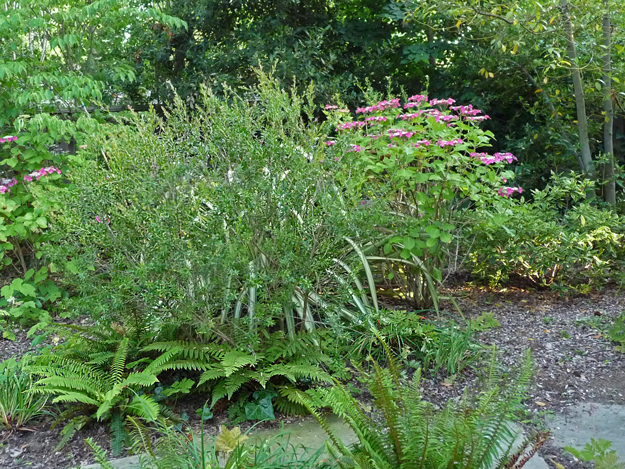
To be sure, these hydrangea are shy for good reason. You can see here how more low plantings just might be a good idea to disguise their short-comings.
- They’re deciduous, as in the leaves fall off after when the plant’s done blooming.
- They’re prone to legginess – i.e. lots of naked stalks – if you forget to cut them back.
- Their low flower to leaf ratio, charming in dappled shade, might reveal all kinds of browning and spotting were they planted front and center.
Perhaps I could do something about the biological fraying, but if it involves chemicals and fussing, no. Water, inspect, and subject to long chats is my plant care strategy.
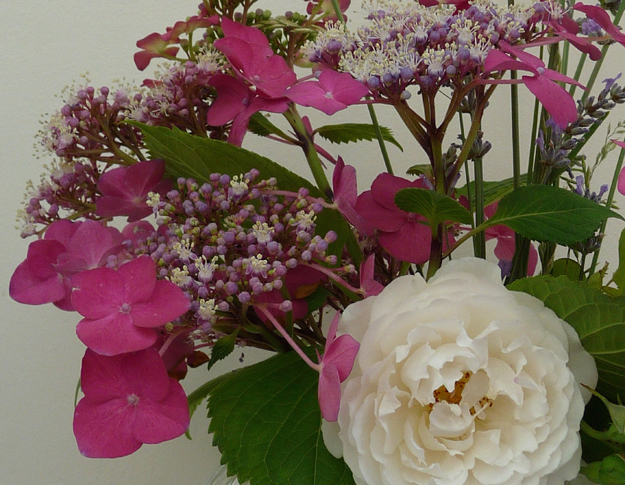
You might think to collect some of the pink for a brief moment of shape and color, as I did here, but prepare to be sweeping up endless small floral bits. Shy creatures offer all kinds of joy from afar but may protest close quarters.
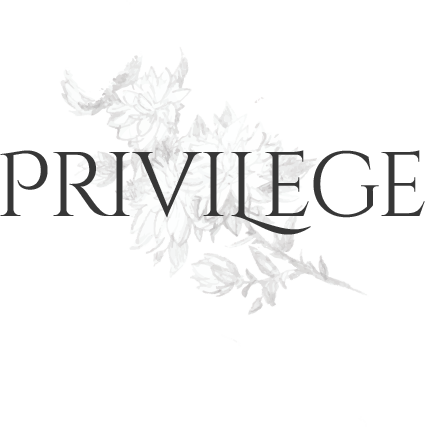
30 Responses
every garden benefits from a hydrangea or two! Love that variegated variety.
I have two different types of hydrangeas, both of which drop pitifully when I decide to bring them in and make arrangements. But, oh, how I love them!
I’m with you on the plant-care strategy. No muss, no fuss. I also add a perennial dose of gratitude and respect for anything that can survive Colorado’s annual cornucopia of brutal sun, snow, hail, drought, and arctic cold.
Your garden is beautiful; the photos look so cool and restful.
@Artsy in Boulder (Debbie), Thank you very much.
Oh, beautiful! And peaceful.
My hydrangeas are showy, demanding attention! Look at me, I’m gorgeous! lol!
What a lovely view you have of your garden from your home. Hydrangeas are one of my favorites and I’m a no-fuss gardener too. I always have an arrangement of dried hydrangeas in the fall.
Sam
I love all varieties of hydrangea, the shy and the diva, and all permutations in between. Your garden is lovely. I find woodland and woodlandish gardens so relaxing and calming.
Lisa, what a beautiful garden!!! These are Hydrangea serrata, Mountain hydrangea,appropriate for woodland gardens. Most are lace-cap, beautiful & delicate. I grow both these and the huge Hydrangea arborescens ‘Annabelle’ and of course the big blue Mopheads… because sometimes you need a sequined dress!
OOps! just reviewed the photos. They are NOT H. serrata. These are Hydrangea macrophylla the Lace-Cap varieties. Sorry bout that. They are still stunning!!
I have three very helpful hydrangeas; the first is a white lace cap climbing hydrangea which has smothered a rather ugly old wall and has been flowering beautifully now for almost four weeks in a recent hot spell here in the UK. The second (and my favourite) is one my mother bought for me, it’s against another part of said wall and has black stems and deep blue lace caps – it’s almost ready to flower and I can’t wait as it looks utterly gorgeous in full bloom. The third I bought from the Royal Horticultural Society gardens at Wisley, which didn’t do too well in it’s first few seasons, but now is a glorious white mop head in a silver and white border – what joy they all bring!
@Julia Sugden, I appreciate the idea of plants being Helpful. A very Sturdy idea indeed:).
My diva hydrangeas get water, a brief chat and the occasional pruning for inclusion in a bouquet or for tidying up. Love them. Love your garden: it oozes peace.
Lisa, your woodland garden is so lovely.
I have been working diligently on replanting my sunny Southern California garden with plants that have flowers in cool hues of blue, pink and purple. My Endless Summer hydrangeas are my favorite. If only they would bloom all year long.
I adore hydrangeas soooo much! No technicaly reason just always have. By the way this summer’s Martha has done a big article on hydrangeas and the different types. Was v interesting.
@coulda shoulda woulda, I’ll look for the link, thanks.
I’ve loved hydrangeas since I was a child and couldn’t pronounce the name. But they like shade and, alas, The Drought and then The Winter put paid to my pines and all 13 of them had to be removed, taking with them all shade from the backyard.
This year I’m studying my options for replanting. White peonies keep appearing in my dreams, alongside old-fashioned shrub roses and masses of day lillies.
That odd bush in your woods: it looks spirea-ish. ? Where are the Hattats? They’d know!
@Beth Waltz, Should I go ask for their guidance? I’ll answer that myself, yes! I should.
I love hydrangeas in all their various forms. Wish they didn’t look so bad though in winter and had to be cut back, etc. But maybe it’s good, because I might now plant anything else if they looked good year round!
I too love hydrangeas and the limelights are my favourites.
Nice to see that you have been gardening a lot these days…fresh air, sunshine and exercise plus a gorgeous garden to admire.
I confess to loving the big blowsy kind. Mine are half the size due to the harsh winter we had, but they are starting to revive a bit.
@Stephanie @ La Dolce Vita, We all have our favorites, luckily the hydrangeas don’t seem to care;)
Ooh, I do love a good hydrangea! I also love a casual (almost messy) garden – one that looks natural and relaxed and like it almost popped up by itself. Your woodland spot is lovely.
In New Zealand when we bought our house it had basically nothing in the way of a garden. It did have two tiny stalks of hydrangea. Three years later, the two stalks grew into huge bushes about 1.5 meters round. They didn’t need any work other than pruning in autumn. They were the traditional blue colour.
I do love all the white/blue/purple/pink shades that hydrangeas come in. I’ve often thought I’d like a bathroom decorated in shades of hydrangea.
@Eleanorjane, Hydrangea make great wallpaper too, don’t you think?
I love this look at your garden. I could spend some restful time there and help you with the weeding, an unusual pleasure of mine.
I brought in a few lacecaps for the last FITH, wow, that’s a lotta pollen.
I was secretly glad when they gave us the ghost and I could throw the whole thing out.
The variegated variety has always been a favorite of mine.
I’m enjoying your retirement. More time=more Lisa.
xo J
@flwjane, Aw thanks. I’d LOVE to spend a day with you weeding, laying bark, light pruning, all the tasks like that. They are fun to do, but daunting solo. Then I could make dinner on the grill and we could eat on the patio:).
Beautiful. Some garden writer I once read said that the pinky-purple of your lace cap hydrangeas is nature’s default color. Perhaps that makes it the very best color for all gardens in all seasons?
Comments are closed.